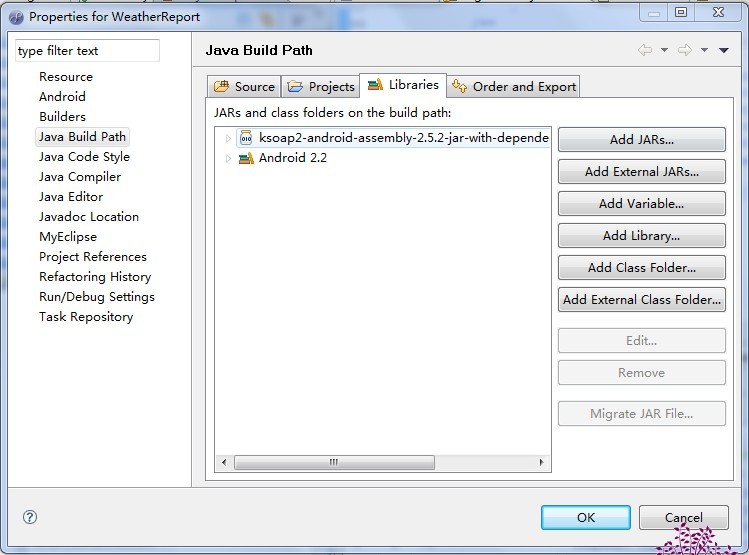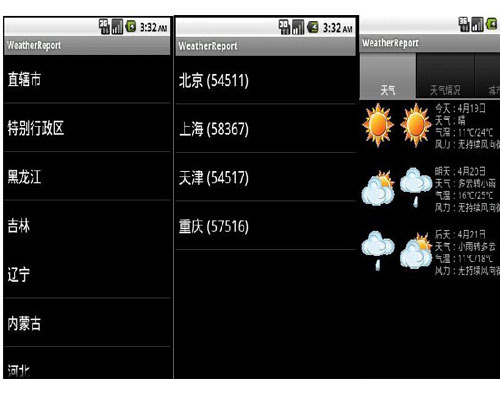您好,登錄后才能下訂單哦!
您好,登錄后才能下訂單哦!
今天就跟大家聊聊有關Android中怎么與服務器端數據進行交互,可能很多人都不太了解,為了讓大家更加了解,小編給大家總結了以下內容,希望大家根據這篇文章可以有所收獲。
?首先下載KSOAP包:
ksoap2-android-assembly-2.5.2-jar-with-dependencies.jar
然后新建android項目:并把下載的KSOAP包放在android項目的lib目錄下:右鍵->build path->configure build path--選擇Libraries,如圖:

以下分為七個步驟來調用WebService方法:
1、實例化SoapObject 對象,指定webService的命名空間(從相關WSDL文檔中可以查看命名空間),以及調用方法名稱。如:
//命名空間 private static final String serviceNameSpace="http://WebXml.com.cn/"; //調用方法(獲得支持的城市) private static final String getSupportCity="getSupportCity"; //實例化SoapObject對象 SoapObject request=new SoapObject(serviceNameSpace, getSupportCity);
2、假設方法有參數的話,設置調用方法參數
request.addProperty("參數名稱","參數值");3、設置SOAP請求信息(參數部分為SOAP協議版本號,與你要調用的webService中版本號一致):
//獲得序列化的Envelope SoapSerializationEnvelope envelope=new SoapSerializationEnvelope(SoapEnvelope.VER11); envelope.bodyOut=request;
4、注冊Envelope,
?(new MarshalBase64()).register(envelope);
5、構建傳輸對象,并指明WSDL文檔URL:
//請求URL private static final String serviceURL="http://www.webxml.com.cn/webservices/weatherwebservice.asmx"; //Android傳輸對象 AndroidHttpTransport transport=new AndroidHttpTransport(serviceURL); transport.debug=true;
6、調用WebService(其中參數為1:命名空間+方法名稱,2:Envelope對象):
transport.call(serviceNameSpace+getWeatherbyCityName, envelope);
7、解析返回數據:
if(envelope.getResponse()!=null){ return parse(envelope.bodyIn.toString()); } /************** * 解析XML * @param str * @return */ private static List<String> parse(String str){ String temp; List<String> list=new ArrayList<String>(); if(str!=null && str.length()>0){ int start=str.indexOf("string"); int end=str.lastIndexOf(";"); temp=str.substring(start, end-3); String []test=temp.split(";"); for(int i=0;i<test.length;i++){ if(i==0){ temp=test[i].substring(7); }else{ temp=test[i].substring(8); } int index=temp.indexOf(","); list.add(temp.substring(0, index)); } } return list; }這樣就成功啦。那么現在我們就來測試下吧,這里有個地址提供webService天氣預報的服務的,我這里只提供獲取城市列表:
//命名空間 private static final String serviceNameSpace="http://WebXml.com.cn/"; //請求URL private static final String serviceURL="http://www.webxml.com.cn/webservices/weatherwebservice.asmx"; //調用方法(獲得支持的城市) private static final String getSupportCity="getSupportCity"; //調用城市的方法(需要帶參數) private static final String getWeatherbyCityName="getWeatherbyCityName"; //調用省或者直轄市的方法(獲得支持的省份或直轄市) private static final String getSupportProvince="getSupportProvince";
我們選擇獲取國內外主要城市或者省份的方法吧:getSupportProvice,然后調用,你會發現瀏覽器返回給我們的是xml文檔:
<?xml version="1.0" encoding="utf-8" ?> <ArrayOfString xmlns:xsi="http://www.w3.org/2001/XMLSchema-instance" xmlns:xsd="http://www.w3.org/2001/XMLSchema" xmlns="http://WebXml.com.cn/"> <string>直轄市</string> <string>特別行政區</string> <string>黑龍江</string> <string>吉林</string> <string>遼寧</string> <string>內蒙古</string> <string>河北</string> <string>河南</string> <string>山東</string> <string>山西</string> <string>江蘇</string> <string>安徽</string> <string>陜西</string> <string>寧夏</string> <string>甘肅</string> <string>青海</string> <string>湖北</string> <string>湖南</string> <string>浙江</string> <string>江西</string> <string>福建</string> <string>貴州</string> <string>四川</string> <string>廣東</string> <string>廣西</string> <string>云南</string> <string>海南</string> <string>新疆</string> <string>西藏</string> <string>臺灣</string> <string>亞洲</string> <string>歐洲</string> <string>非洲</string> <string>北美洲</string> <string>南美洲</string> <string>大洋洲</string> </ArrayOfString>
我們可以用 listview來顯示:
那么下面我將給出全部代碼:
public class WebServiceHelper { //WSDL文檔中的命名空間 private static final String targetNameSpace="http://WebXml.com.cn/"; //WSDL文檔中的URL private static final String WSDL="http://webservice.webxml.com.cn/WebServices/WeatherWebService.asmx?wsdl"; //需要調用的方法名(獲得本天氣預報Web Services支持的洲、國內外省份和城市信息) private static final String getSupportProvince="getSupportProvince"; //需要調用的方法名(獲得本天氣預報Web Services支持的城市信息,根據省份查詢城市集合:帶參數) private static final String getSupportCity="getSupportCity"; //根據城市或地區名稱查詢獲得未來三天內天氣情況、現在的天氣實況、天氣和生活指數 private static final String getWeatherbyCityName="getWeatherbyCityName"; /******** * 獲得州,國內外省份和城市信息 * @return */ public List<String> getProvince(){ List<String> provinces=new ArrayList<String>(); String str=""; SoapObject soapObject=new SoapObject(targetNameSpace,getSupportProvince); //request.addProperty("參數", "參數值");調用的方法參數與參數值(根據具體需要可選可不選) SoapSerializationEnvelope envelope=new SoapSerializationEnvelope(SoapEnvelope.VER11); envelope.dotNet=true; envelope.setOutputSoapObject(soapObject);//envelope.bodyOut=request; AndroidHttpTransport httpTranstation=new AndroidHttpTransport(WSDL); //或者HttpTransportSE httpTranstation=new HttpTransportSE(WSDL); try { httpTranstation.call(targetNameSpace+getSupportProvince, envelope); SoapObject result=(SoapObject)envelope.getResponse(); //下面對結果進行解析,結構類似json對象 //str=(String) result.getProperty(6).toString(); int count=result.getPropertyCount(); for(int index=0;index<count;index++){ provinces.add(result.getProperty(index).toString()); } } catch (IOException e) { // TODO Auto-generated catch block e.printStackTrace(); } catch (XmlPullParserException e) { // TODO Auto-generated catch block e.printStackTrace(); } return provinces; } /********** * 根據省份或者直轄市獲取天氣預報所支持的城市集合 * @param province * @return */ public List<String> getCitys(String province){ List<String> citys=new ArrayList<String>(); SoapObject soapObject=new SoapObject(targetNameSpace,getSupportCity); soapObject.addProperty("byProvinceName", province); SoapSerializationEnvelope envelope=new SoapSerializationEnvelope(SoapEnvelope.VER11); envelope.dotNet=true; envelope.setOutputSoapObject(soapObject); AndroidHttpTransport httpTransport=new AndroidHttpTransport(WSDL); try { httpTransport.call(targetNameSpace+getSupportCity, envelope); SoapObject result=(SoapObject)envelope.getResponse(); int count=result.getPropertyCount(); for(int index=0;index<count;index++){ citys.add(result.getProperty(index).toString()); } } catch (IOException e) { // TODO Auto-generated catch block e.printStackTrace(); } catch (XmlPullParserException e) { // TODO Auto-generated catch block e.printStackTrace(); } return citys; } /*************************** * 根據城市信息獲取天氣預報信息 * @param city * @return ***************************/ public WeatherBean getWeatherByCity(String city){ WeatherBean bean=new WeatherBean(); SoapObject soapObject=new SoapObject(targetNameSpace,getWeatherbyCityName); soapObject.addProperty("theCityName",city);//調用的方法參數與參數值(根據具體需要可選可不選) SoapSerializationEnvelope envelope=new SoapSerializationEnvelope(SoapEnvelope.VER11); envelope.dotNet=true; envelope.setOutputSoapObject(soapObject);//envelope.bodyOut=request; AndroidHttpTransport httpTranstation=new AndroidHttpTransport(WSDL); //或者HttpTransportSE httpTranstation=new HttpTransportSE(WSDL); try { httpTranstation.call(targetNameSpace+getWeatherbyCityName, envelope); SoapObject result=(SoapObject)envelope.getResponse(); //下面對結果進行解析,結構類似json對象 bean=parserWeather(result); } catch (IOException e) { // TODO Auto-generated catch block e.printStackTrace(); } catch (XmlPullParserException e) { // TODO Auto-generated catch block e.printStackTrace(); } return bean; } /** * 解析返回的結果 * @param soapObject */ protected WeatherBean parserWeather(SoapObject soapObject){ WeatherBean bean=new WeatherBean(); List<Map<String,Object>> list=new ArrayList<Map<String,Object>>(); Map<String,Object> map=new HashMap<String,Object>();//城市名 bean.setCityName(soapObject.getProperty(1).toString());//城市簡介 bean.setCityDescription(soapObject.getProperty(soapObject.getPropertyCount()-1).toString()); bean.setLiveWeather(soapObject.getProperty(10).toString()+"\n"+soapObject.getProperty(11).toString()); //其他數據 //日期, String date=soapObject.getProperty(6).toString(); String weatherToday="今天:" + date.split(" ")[0]; weatherToday+="\n天氣:"+ date.split(" ")[1]; weatherToday+="\n氣溫:"+soapObject.getProperty(5).toString(); weatherToday+="\n風力:"+soapObject.getProperty(7).toString(); weatherToday+="\n"; List<Integer> icons=new ArrayList<Integer>(); icons.add(parseIcon(soapObject.getProperty(8).toString())); icons.add(parseIcon(soapObject.getProperty(9).toString())); map.put("weatherDay", weatherToday); map.put("icons",icons); list.add(map); map=new HashMap<String,Object>(); date=soapObject.getProperty(13).toString(); String weatherTomorrow="明天:" + date.split(" ")[0]; weatherTomorrow+="\n天氣:"+ date.split(" ")[1]; weatherTomorrow+="\n氣溫:"+soapObject.getProperty(12).toString(); weatherTomorrow+="\n風力:"+soapObject.getProperty(14).toString(); weatherTomorrow+="\n"; icons=new ArrayList<Integer>(); icons.add(parseIcon(soapObject.getProperty(15).toString())); icons.add(parseIcon(soapObject.getProperty(16).toString())); map.put("weatherDay", weatherTomorrow); map.put("icons",icons); list.add(map); map=new HashMap<String,Object>(); date=soapObject.getProperty(18).toString(); String weatherAfterTomorrow="后天:" + date.split(" ")[0]; weatherAfterTomorrow+="\n天氣:"+ date.split(" ")[1]; weatherAfterTomorrow+="\n氣溫:"+soapObject.getProperty(17).toString(); weatherAfterTomorrow+="\n風力:"+soapObject.getProperty(19).toString(); weatherAfterTomorrow+="\n"; icons=new ArrayList<Integer>(); icons.add(parseIcon(soapObject.getProperty(20).toString())); icons.add(parseIcon(soapObject.getProperty(21).toString())); map.put("weatherDay", weatherAfterTomorrow); map.put("icons",icons); list.add(map); bean.setList(list); return bean; } //解析圖標字符串 private int parseIcon(String data){ // 0.gif,返回名稱0, int resID=32; String result=data.substring(0, data.length()-4).trim(); // String []icon=data.split("."); // String result=icon[0].trim(); // Log.e("this is the icon", result.trim()); if(!result.equals("nothing")){ resID=Integer.parseInt(result.trim()); } return resID; //return ("a_"+data).split(".")[0]; } }上就是我所作的查詢天氣預報的全部核心代碼了,讀者可以根據注釋以及本文章了解下具體實現,相信很快就搞明白了,運行結果如下:

看完上述內容,你們對Android中怎么與服務器端數據進行交互有進一步的了解嗎?如果還想了解更多知識或者相關內容,請關注億速云行業資訊頻道,感謝大家的支持。
免責聲明:本站發布的內容(圖片、視頻和文字)以原創、轉載和分享為主,文章觀點不代表本網站立場,如果涉及侵權請聯系站長郵箱:is@yisu.com進行舉報,并提供相關證據,一經查實,將立刻刪除涉嫌侵權內容。